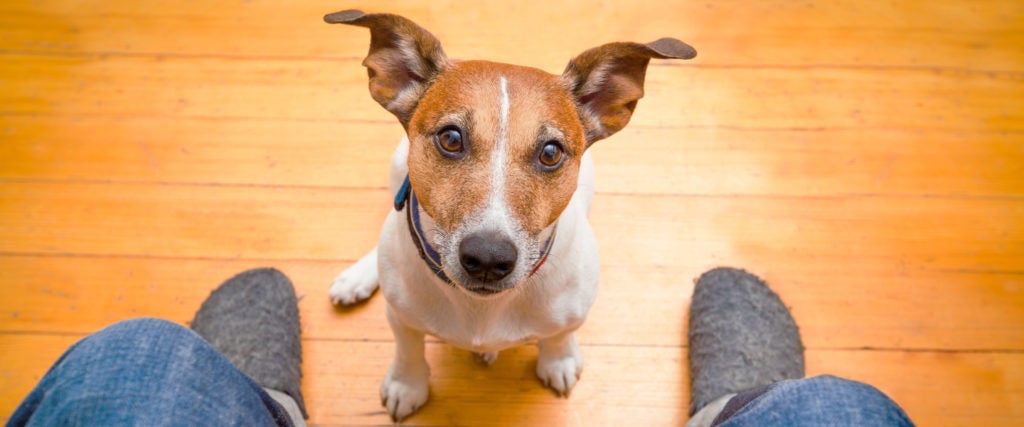Not long ago, dog parents saw spending more time with their four-legged friends as the bright side of quarantine. Now, many are grumbling about their hounds “acting super needy” and just generally being annoying. Some are even predicting an “epidemic of separation anxiety after the quarantine,” a possible result of spending too much time together.
But are our animals actually becoming needy, or are we humans just unappreciative of their bottomless affection?
That depends on how you look at it.
"My new quarantine coworker is so needy, I can't get anything done."
(ginny_the_woof / IG) pic.twitter.com/89P0goM65G#Twittblaster #TwittblasterGIF #TwittblasterAnimals #TwittblasterDogs #Dogs #dogsoftwitter #WoofWoofTV #QuarantineLife #StayHomeSaveLive #COVID19 #StaySafe— Pat Chan-Schatz (@Twittblaster) March 27, 2020
Jessica Pierce, bioethicist and author of numerous books about pets, including Unleashing Your Dog: A Field Guide to Giving Your Canine Companion the Best Possible Life, says, “Dogs are getting used to having their people around more often. Like humans, dogs are creatures of habit, and for many dogs, the daily routine over the past five months has involved spending lots of time around the house with their human. They may have gotten used to long periods of togetherness. An abrupt change in this pattern will be hard.”
That said, blaming our dogs for reveling in the extra time with us or labeling their changed behavior as “needy” is pretty cold. “One thing this pandemic has done is shine a light on how hard social isolation can be,” Pierce says. “We humans are getting a taste of what many dogs experience every day, or at least what they experienced pre-COVID. Dogs are highly social and form strong emotional attachments to us. So I’d like to reframe the language of ‘needy dogs’ to ‘dogs who need and enjoy social support and closeness.’ Labeling dogs as ‘emotionally needy’ puts a negative spin on what they’re experiencing and suggests that their feelings of anxiety, insecurity or loneliness are pathological. We habituate dogs to need us — for example, by adopting puppies during the sensitive period between eight and 12 weeks — so we shouldn’t be surprised when they actually do.”
In other words, we should be sympathetic to our dogs cherishing quarantine and trailing us around the house, not annoyed. “In a peculiar way, COVID has had a positive effect on humans, causing more family interaction, and more direct time and attention spent with our family pets,” says Jerry Klein, chief veterinary officer at the American Kennel Club. “The quarantine during this pandemic has also caused a spike in new dog and cat adoptions and ownerships. These new dogs and cats have been raised on this altered schedule with no previous knowledge of a ‘former’ routine, and they assume that their lives will always be like the one they’re currently living.”
The main message here is that we should respond to our increasingly attached dogs with love and affection, not by giving them the cold shoulder. “We can help dogs form and maintain secure attachments by being emotionally available and predictable,” Pierce says.
I suggest bringing this attitude along as you work to make sure your dog copes with post-quarantine life using the tips below.
Ease Them Into Your New Schedule
“As some of us slowly return to our previous lifestyles and work schedules, our dogs may not understand the change in their schedule,” Klein explains. Therefore, he says, “Ease back at least a few days before you return to work by creating a consistent schedule for bedtime, wake time, meals and walks. Try to gradually social distance from your dog by encouraging them to spend time in their own bed, outside in a fenced yard or in their crate while you perform tasks or errands that don’t involve them. Start with small time periods and work up to longer periods and distances.”
That way, Pierce says, “You aren’t just there one day and gone the next.”
When You Do Leave, Give Them Stuff to Do
“Make your leaving a natural part of the day,” Klein suggests. “Don’t make a big fuss before you depart. Perhaps give your dog a treat that will take a while to consume to distract them as you depart.”
“Always be sure your pet has what it needs while you’re gone,” he continues. “Stuff like plenty of fresh drinking water, the ability to stand and move around, a comfortable place to sleep, such as a soft dog bed, and the ability to relieve itself every four to six hours.” He adds that “safe, interactive toys, such as puzzle toys” can be fun for dogs, too — just be extra careful about them accidentally choking while you’re away.
If you must, Klein says, “Consider hiring the services of a licensed dog walker to help facilitate you and your dog’s needs during work hours.”
And Again, Love Them Lots
“Dogs who have plenty of physical, mental and emotional stimulation may be very content with periods of quiet rest,” Pierce says. “So if you know that you’re going to be returning to work or school — or otherwise leaving your dog alone for periods of time — make sure he or she gets lots of exercise, love and fulfillment.”
If even that doesn’t stop them from freaking out when you go back to the office, you may need to enlist the help of a professional. “If you follow these steps and your dog still has problems with separation anxiety, talk with your veterinarian,” Klein suggests. “They may be able to recommend medications or other products to use while you work with a trainer to help overcome your dog’s anxiety.”
In the meantime, go give your dog a pat on the head to let them know you appreciate how much they appreciate you being home more these days.

